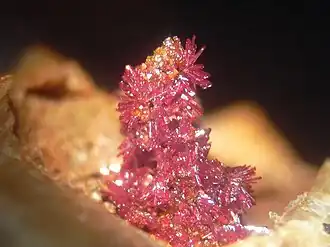Iranite
| Iranite | |
|---|---|
 | |
| General | |
| Category | Silicate mineral |
| Formula | Pb10Cu(CrO4)6(SiO4)2(F,OH)2 |
| IMA symbol | Irn[1] |
| Strunz classification | 7.FC.15 |
| Crystal system | Triclinic |
| Space group | Triclinic pedial H-M symbol: (1) Space group: P1 |
| Unit cell | a = 10.02 Å, b = 9.54 Å, c = 9.89 Å; α = 104.5°, β = 66°, γ = 108.5°; Z = 1 |
| Identification | |
| Color | Brown to orange |
| Crystal habit | Equant to flattened euhedral crystals |
| Mohs scale hardness | 3 |
| Luster | Vitreous |
| Streak | Yellow |
| Specific gravity | 5.8 |
| Optical properties | Biaxial |
| Refractive index | nα = 2.250 – 2.300 nγ = 2.400 – 2.500 |
| Birefringence | δ = 0.150 – 0.200 |
| References | [2][3][4] |
Iranite (Persian: ایرانیت) is a triclinic lead copper chromate silicate mineral with formula Pb10Cu(CrO4)6(SiO4)2(F,OH)2. It was first described from an occurrence in Iran. It is the copper analogue of hemihedrite (Pb10Zn(CrO4)6(SiO4)2(F,OH)2).[3]
It occurs as an oxidation product of hydrothermal lead-bearing veins. Associated minerals include dioptase, fornacite, wulfenite, mimetite, cerussite and diaboleite.[2] It was first described in 1970 for an occurrence in the Sebarz Mine, northeast of Anarak, Iran.[3][2]
References
- ^ Warr, L.N. (2021). "IMA–CNMNC approved mineral symbols". Mineralogical Magazine. 85 (3): 291–320. Bibcode:2021MinM...85..291W. doi:10.1180/mgm.2021.43. S2CID 235729616.
- ^ a b c Handbook of Mineralogy
- ^ a b c Mindat page for Iranite
- ^ Webmineral data for Iranite
Wikimedia Commons has media related to Iranite.